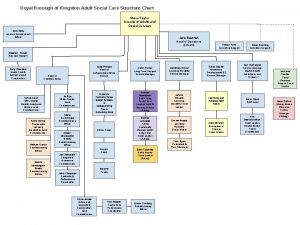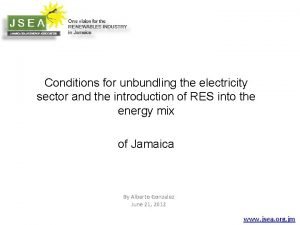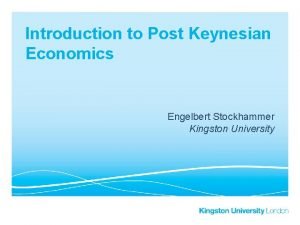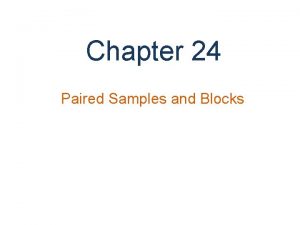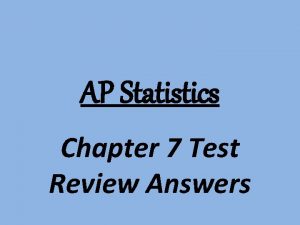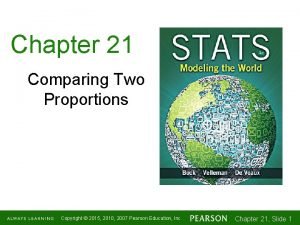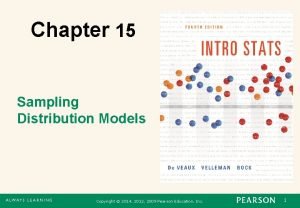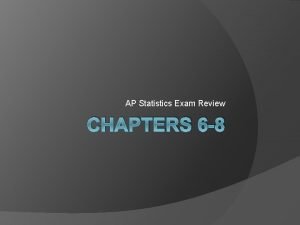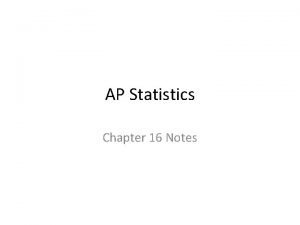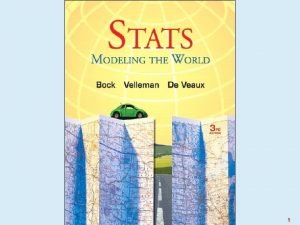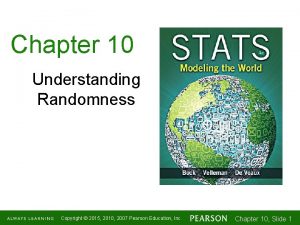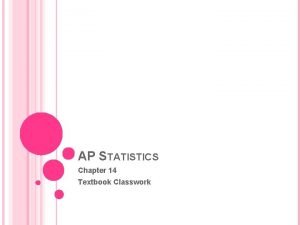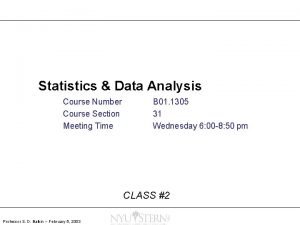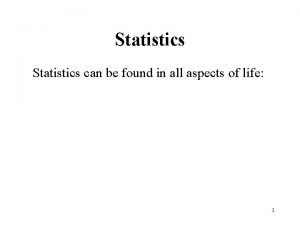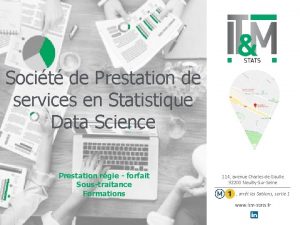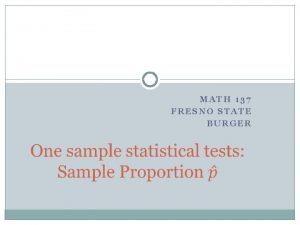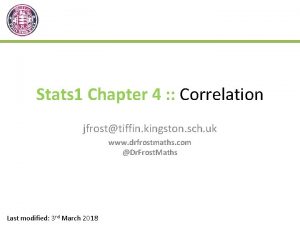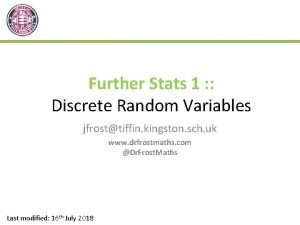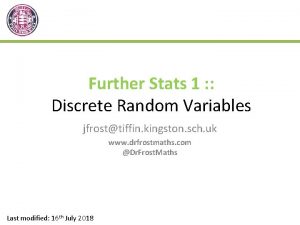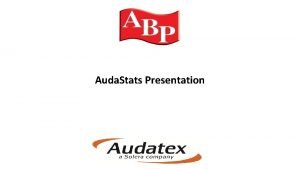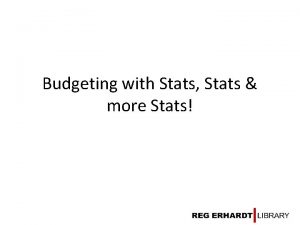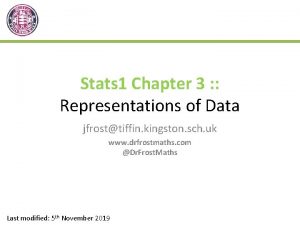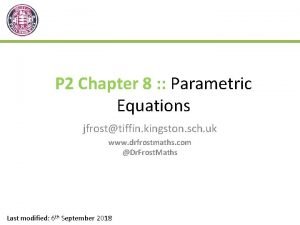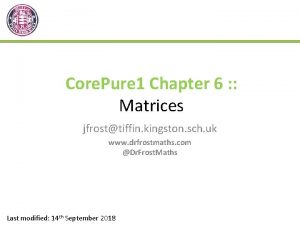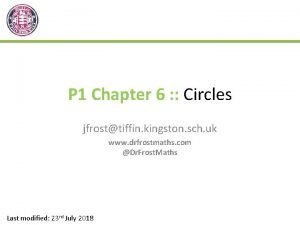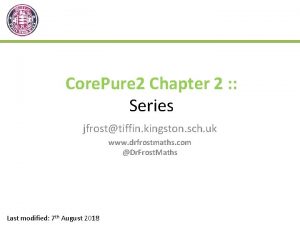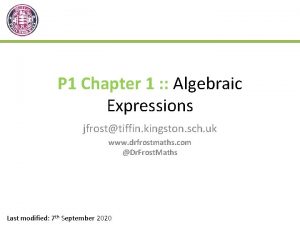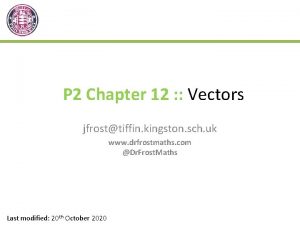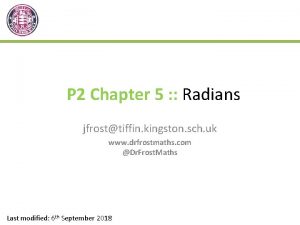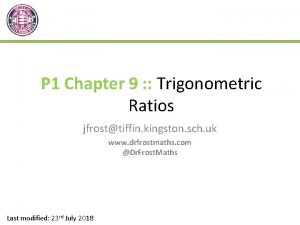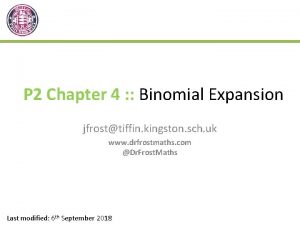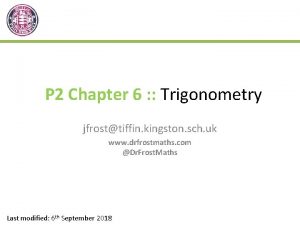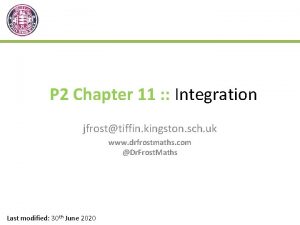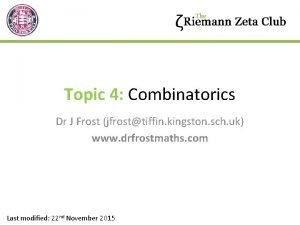Stats 1 Chapter 1 Data Collection jfrosttiffin kingston



























![Example Questions Hurn © Crown Copyright Met Office 1987 [Textbook] (a) Describe the type Example Questions Hurn © Crown Copyright Met Office 1987 [Textbook] (a) Describe the type](https://slidetodoc.com/presentation_image_h/00355719b227bff41cb22ad65e7863c3/image-28.jpg)
![Example Questions Hurn © Crown Copyright Met Office 1987 [Textbook] Calculate: a) The mean Example Questions Hurn © Crown Copyright Met Office 1987 [Textbook] Calculate: a) The mean](https://slidetodoc.com/presentation_image_h/00355719b227bff41cb22ad65e7863c3/image-29.jpg)

- Slides: 30

Stats 1 Chapter 1 : : Data Collection jfrost@tiffin. kingston. sch. uk www. drfrostmaths. com @Dr. Frost. Maths Last modified: 5 th November 2019

www. drfrostmaths. com Everything is completely free. Why not register? Register now to interactively practise questions on this topic, including past paper questions and extension questions (including MAT + UKMT). Teachers: you can create student accounts (or students can register themselves), to set work, monitor progress and even create worksheets. With questions by: Dashboard with points, trophies, notifications and student progress. Questions organised by topic, difficulty and past paper. Teaching videos with topic tests to check understanding.

The chapters of Stats Year 1 could be broadly organised as follows: Experimental i. e. Dealing with collected data. Chp 1: Data Collection Methods of sampling, types of data, and populations vs samples. Chp 2: Measures of Location/Spread Chp 3: Representation of Data Statistics used to summarise data, including mean, standard deviation, quartiles, percentiles. Use of linear interpolation for estimating medians/quartiles. Producing and interpreting visual representations of data, including box plots and histograms. Chp 4: Correlation Measuring how related two variables are, and using linear regression to predict values. Theoretical Deal with probabilities and modelling to make inferences about what we ‘expect’ to see or make predictions, often using this to reason about/contrast with experimentally collected data. Chp 5: Probability Venn Diagrams, mutually exclusive + independent events, tree diagrams. Chp 6: Statistical Distributions Chp 7: Hypothesis Testing Common distributions used to easily find probabilities under certain modelling conditions, e. g. binomial distribution. Determining how likely observed data would have happened ‘by chance’, and making subsequent deductions.

This Chapter Overview Interestingly, most of this chapter is from the old S 3 module (a Further Maths module!) with also some S 2. There is little ‘calculation’ involved in this chapter; consider this a ‘bookwork’ one! 1: : Populations vs samples 2: : Random Sampling “Suggest why we would not test all the light bulbs. ” “Identify the sampling frame. ” Describe the disadvantages of systematic sampling. 4: : Types of data 3: : Non-Random Sampling Describe how a stratified sample would be conducted, including strata sizes. Continuous vs discrete, terms such as class intervals, class boundaries, class width. 5: : Edexcel’s ‘Large Data Set’ What you’re expected to know about the ‘large data set’ of weather data, and how to use it.

Populations and samples Population Sample ! A population is: A sample is: the whole set of items that are of interest. ? some subset of the population intended to represent the population. ? You’re probably used to a ‘population’ meaning all humans/animals within a country/ecosystem. But a population could be “all the lightbulbs in a factory” or “all the cars in the UK”.

Sampling key terms Population Sample ! Each individual thing in the population that can be sampled is known as a sampling unit. ! Often sampling units of a population are individually named or numbered to form a list called the sampling frame.

Populations vs Samples We could collect data either from a sample, or from the entire population. Data collected from the entire population is known as a census. ? Advantages Disadvantages Census Should give completely accurate result. ? • Time consuming and expensive. • Can not be used when testing involves destruction. ? • Large volume of data to process. Sample • Cheaper. • Quicker. ? • Less data to process. • Data may not be accurate. • Data may not be large enough to represent small ? sub-groups. Example: A supermarket wants to test a delivery of avocados for ripeness by cutting them in half. a. Suggest a reason why the supermarket should not test all the avocados in the delivery. b. The supermarket tests a sample of 5 avocados and finds that 4 of them are ripe. They estimate that 80% of the avocados in the deliver are ripe. Suggest one way that the supermarket could improve their estimate. a Testing the avocados destroys them (and thus can’t be sold). ? b Use a larger sample size (as this would be better estimate of ? the proportion of ripe avocados).

Exercise 1 A Pearson Statistics & Mechanics Year 1/AS Page 3

Types of Sampling I recommend laying out your notes like this for next bit of the chapter. Use a full page. Non-Random Sampling Type Simple Random Sampling Systematic Sampling Stratified Sampling Quota Sampling Opportunity Sampling How to carry out Advantages Disadvantages

Random Sampling Population Ordinarily, we would want each thing in our sampling frame to have an equal chance of being chosen, in order to avoid bias. This is known as random sampling. There a few ways of doing this…

Simple Random Sampling Type How to carry out What is it : Every sample has an equal chance of being selected. ? Method: Simple Random In sampling frame each Sampling item has identifying • • • Advantages Disadvantages Bias free. • Easy and cheap to implement. Each number has a • known equal chance of being selected. Not suitable when population size is large. Sampling frame needed. ? ? number. Use random number generator, or ‘lottery sampling’ (names in a hat). ? Edexcel S 3 June 2004 Q 1 a There are 64 girls and 56 boys in a school. Explain briefly how you could take a random sample of 15 pupils using a simple random sample. (3) Mark for allocating identifier to each sampling unit. ? Mark for one (bias-free) method to select such a number. Mark for explicitly mentioning how that number is actually used.

Systematic Sampling Type How to carry out Advantages • • Systematic Sampling Simple and quick to use. Suitable for large samples/ populations. ? ? Disadvantages • • Sampling frame again needed. Can introduce bias if sampling frame not random. ? Edexcel S 3 June 2009 Q 1 a A telephone directory contains 50 000 names. A researcher wishes to select a systematic sample of 100 names from the directory. Explain in detail how the researcher should obtain such a sample. (2) ? We need a random first item.

Stratified Sampling Population We want to sample 20% of the population. If the population were divided into distinct groups (e. g. age ranges), known as ‘strata’, we could randomly sample 20% from each group, ensuring each group is equally represented. Type How to carry out Advantages • • Stratified Sampling ? Reflects population structure. Guarantees proportional representation of groups within population. ? Disadvantages • • Population must be clearly classified into distinct strata. Selection within each stratum suffers from same disadvantages as simple random sampling. ?

Example Question Edexcel S 3 Jan 2006 Q 1 A school has 15 classes and a sixth form. In each class there are 30 students. In the sixth form there are 150 students. There are equal numbers of boys and girls in each class. There are equal numbers of boys and girls in the sixth form. The head teacher wishes to obtain the opinions of the students about school uniforms. Explain how the head teacher would take a stratified sample of size 40. (7) ? You would certainly want to know your mark scheme on this one!

Exercise 1 B Pearson Statistics & Mechanics Year 1/AS Pages 6 -7

Non-Random Sampling Famous Lefties Consider the following scenario: You wish to conduct a survey in the UK on whether being left-handed affects IQ. We need to choose people to assess. Why would random sampling be problematic? Because we don’t know the sampling frame, i. e. don’t have a list of? all left-handed (and non-left-handed) people in the UK. OK, maybe not so famous. For this scenario we’d likely use quota sampling, i. e. 1. As with stratified sampling, divide population into groups according to characteristic of interest, then determine size of each group in sample to reflect proportions within the population. 2. But instead of random sampling within each group, we actively choose people within each group via suitable means (e. g. advertising), until the ‘quota’ for each group is filled. A variant of this is opportunity sampling, where we find people at the same time the survey is being carried out (e. g. exit polls at polling stations). This is not a suitable method for the left-handed example, because giving the likely time-consuming nature of assessment coupled with resources required, we’d likely arrange with the people taking part before the actual assessment tasks took place.

Quota & Opportunity Sampling Type Quota Sampling Opportunity/ Convenience Sampling How to carry out What is it : Population divided into groups according to characteristic. A quota of items/people in each group is set to try and reflect the group’s proportion in the whole population. Interviewer selects the actual sampling units. ? Advantages • • Sample taken from • people who are • available at time of study, who meet criteria. ? Disadvantages Allows small sample to still be representative of population. No sampling frame required. Quick, easy, inexpensive. Allows for easy comparison between different groups in population. • Easy to carry out. Inexpensive. • ? ? • • Non-random sampling can introduce bias. Population must be divided into groups, which can be costly or inaccurate. Increasing scope of study increases number of groups, adding time/expense. Non-responses are not recorded. ? Unlikely to provide a representative sample. Highly dependent on individual researcher. ?

Example Question Edexcel S 3 June 2010 Q 2 ? ?

Exercise 1 C Pearson Statistics & Mechanics Year 1/AS Pages 8 -9

Types of Data Qualitative/Categorical Quantitative Non-numerical values, e. g. colour. Numerical values. Note that while discrete variables only allow specific values, the range could still be infinite, e. g. “number of attempts before success”. Discrete Continuous Can only take specific values, e. g. shoe size, number of children. Can take any decimal value (possible with a specified range). Frequency Data can be grouped for conciseness, at the expense of losing the exact original values. This is known as a class interval. ? Lower class boundary ? Midpoint = 45 ? Upper class boundary ? ?

Exercise 1 D Pearson Statistics & Mechanics Year 1/AS Page 10 (This exercise could probably be skipped)

Name That Sampling Method! Simple Random Sampling Systematic Sampling Stratified Sampling Quota Sampling Opportunity Sampling Suggest a suitable sampling method. “You wish to test lightbulbs produced by a factory in a daily batch. ” Probably systematic sampling, as the method of choosing items is simpler than simple random sampling (where it would be time-consuming to find specifically chosen random light bulbs). Sampling frame is known. “You wish to survey consumer opinion on your new drink Fizz. Guzz released in the UK. ” Quota sampling or opportunity sampling. We’d realistically not have access to the sampling frame (i. e. a list of all UK residents). “You wish to determine students’ favourite TV programmes in your school, that is fairly representative of each year group. ” Stratified sampling. We (probably) have access to the sampling frame (i. e. a list of all students). Stratified sampling ensures that each stratum (year group) is proportionately represented. ? ? ?

Large Data Set All A Level exam boards are obligated to provide a ‘large data set’. Data in exam questions will often be from this set, and you are encouraged to explore this data (which is publicly available) in Microsoft Excel. It is important to note that you are expected to be familiar with this data set before you go into your exam, including some basic geographic knowledge! Edexcel’s data set concerns weather data from a number of weather stations. Let’s explore what you might be expected to know… https: //qualifications. pearson. com/content/dam/pdf/A%20 Level/Mathematics/2017/specification-and-sampleassesment/Pearson%20 Edexcel%20 GCE%20 AS%20 and%20 AL%20 Mathematics%20 data%20 set%20 -%20 Issue%201%20(1). xls

What You Need To Be Familiar With… Northern Hemisphere Southern Hemisphere 1 You should know the names and rough locations of the 5 UK weather stations, as well as the 3 international weather stations. The data was recorded for: • May-Oct 1987 • May-Oct 2015

All the following are daily… 2 You should be familiar with the variables involved and their respective units. Mean Windspeed Total rainfall (in mm) tr/trace means less than 0. 05 mm Mean Visibility How far (in metres) can be seen into the horizon during daylight hours. Wind Direction Mean Pressure In hectopascals (h. Pa) Textbook claims this is max temp for UK, but it is mean temp for all locations. Maximum Gust (in kn) is highest instantaneous wind speed. Humidity is the % of air saturation with water vapour. 100% is the maximum % water content air can contain.

3 You should have a vague idea of the range of values for each location. UK Location (2015) Temp Range Wind Speed Range World Location Temp Wind Speed (2015) Range Camborne 10 -20 3 -18 Beijing 8 -33 2 -9 Heathrow 8 -29 3 -19 Jacksonville 15 -31 1 -12 Hurn 6 -24 2 -19 Perth 8 -25 4 -14 Leeming 4 -23 3 -17 Leuchars 4 -19 3 -23 Mean wind speed in UK across full period was roughly 9 nm. But 4 nm in Beijing (i. e. lower), 5 in Jacksonville (again lower), 8 in Perth (similar to UK). Beijing temp range relatively large. Min Jacksonville temp high. Perth similar to UK.

4 You should have a vague idea of the range of values for each variable for the data set as a whole. Variable Typical value(s) Gust (UK only) 8 – 52 nm Rainfall 0 – 60 mm in UK, but more extreme maximums elsewhere (e. g. 102 mm in Perth) Pressure 988 – 1038 h. Pa Wind Speed on Beaufort scale Max is ‘fresh’ (5). Most Light or Moderate. Sunshine (UK only) 0 – 16 hrs Cloud Cover 0 – 8 ocktas (i. e. full spread)
![Example Questions Hurn Crown Copyright Met Office 1987 Textbook a Describe the type Example Questions Hurn © Crown Copyright Met Office 1987 [Textbook] (a) Describe the type](https://slidetodoc.com/presentation_image_h/00355719b227bff41cb22ad65e7863c3/image-28.jpg)
Example Questions Hurn © Crown Copyright Met Office 1987 [Textbook] (a) Describe the type of data represented by daily total rainfall. Alison is investigating daily maximum gust. She wants to select a sample of size 5 from the first 20 days in Hurn in June 1987. She uses the first two digits of the date as a sampling frame and generates five random numbers between 1 and 20. b) State the type of sample selected by Alison. c) Explain why Alison’s process might not generate a sample of size 5. a b As previously noted, the actual data set has mean temperature for all locations. I changed to maximum temperature for this example for consistency with the textbook. c ? Simple random sample. ? Continuous quantitative data. Some of the data values are ? not available (n/a).
![Example Questions Hurn Crown Copyright Met Office 1987 Textbook Calculate a The mean Example Questions Hurn © Crown Copyright Met Office 1987 [Textbook] Calculate: a) The mean](https://slidetodoc.com/presentation_image_h/00355719b227bff41cb22ad65e7863c3/image-29.jpg)
Example Questions Hurn © Crown Copyright Met Office 1987 [Textbook] Calculate: a) The mean daily maximum temperature for the first five days of June in Hurn in 1987. b) The median daily total rainfall for the week of 14 th June to 20 th June inclusive. c) The median daily total rainfall for the same week in Perth was 19. 00 mm. Karl states that more southerly countries experience higher rainfall during June. State with a reason whether your answer to part (b) supports this statement. a b ? ? c ?

Exercise 1 E Pearson Statistics & Mechanics Year 1/AS Pages 13 -15
 Aquajet kingston
Aquajet kingston Adult social care kingston
Adult social care kingston Kingston traffic report
Kingston traffic report Professor margaret kingston
Professor margaret kingston Jps ecommerce kingston 5
Jps ecommerce kingston 5 Prawy hals prawo drogi
Prawy hals prawo drogi On discovery maxine hong kingston
On discovery maxine hong kingston Martin kingston qc
Martin kingston qc Kingston strategic partnership
Kingston strategic partnership Engelbert stockhammer
Engelbert stockhammer Kingston planning scheme
Kingston planning scheme Landsat collection 1 vs collection 2
Landsat collection 1 vs collection 2 Documentary payment
Documentary payment Ap stats chapter 24 paired samples and blocks
Ap stats chapter 24 paired samples and blocks Ap stats chapter 7 test answers
Ap stats chapter 7 test answers Standard error of difference between two proportions
Standard error of difference between two proportions Ap stats chapter 17 sampling distribution models
Ap stats chapter 17 sampling distribution models Chapter 6 ap statistics review
Chapter 6 ap statistics review Ap stats chapter 16
Ap stats chapter 16 Ap stats chapter 17 sampling distribution models
Ap stats chapter 17 sampling distribution models Understanding randomness chapter 10
Understanding randomness chapter 10 Ap stats chapter 14
Ap stats chapter 14 Procedures of data collection
Procedures of data collection The terms external secondary data and syndicated
The terms external secondary data and syndicated Statistics complement rule
Statistics complement rule Experimental unit stats
Experimental unit stats Privisol
Privisol It&m stats
It&m stats Numbers and stats signpost
Numbers and stats signpost Stats p hat
Stats p hat Modality statistics
Modality statistics

